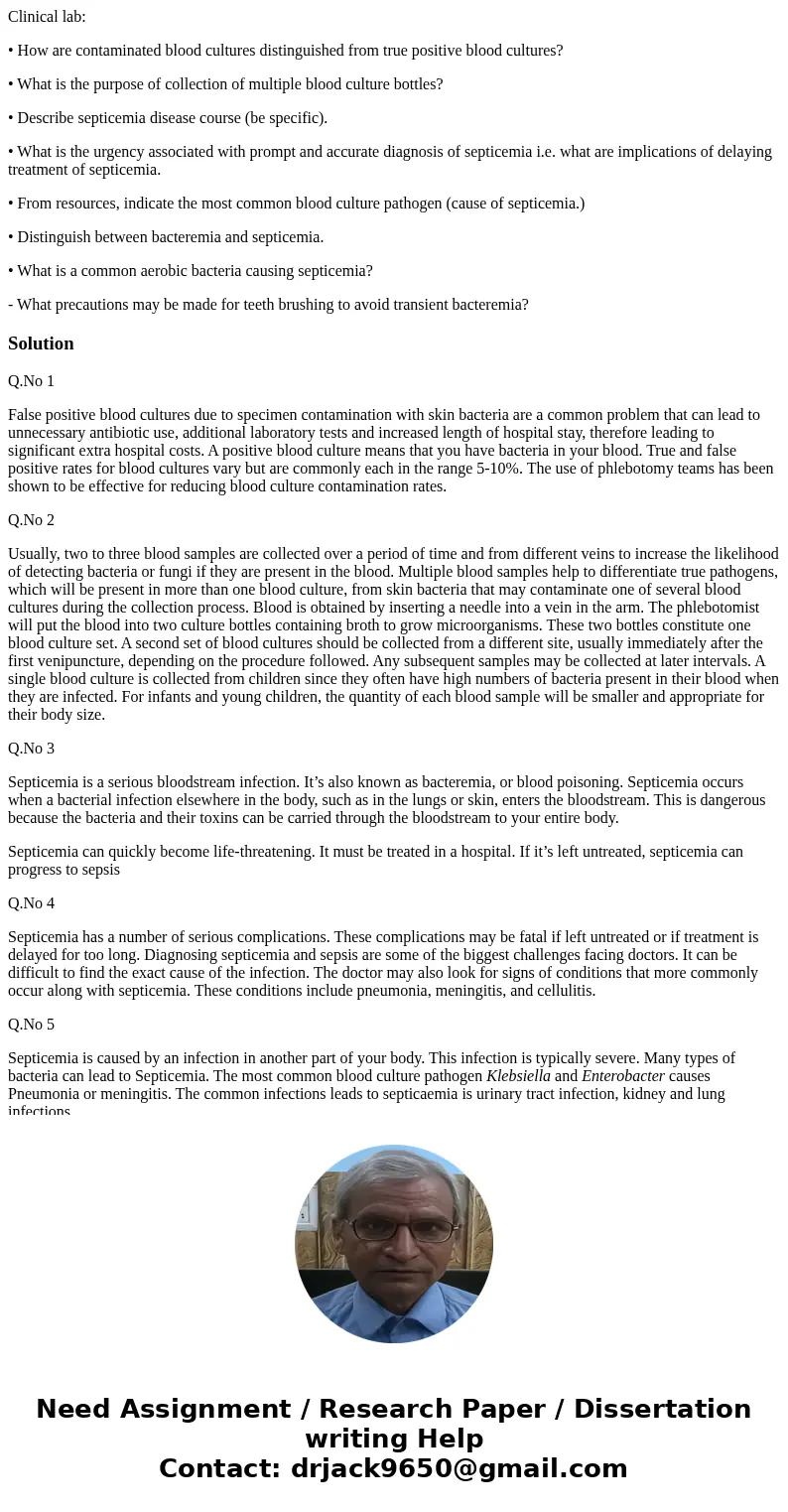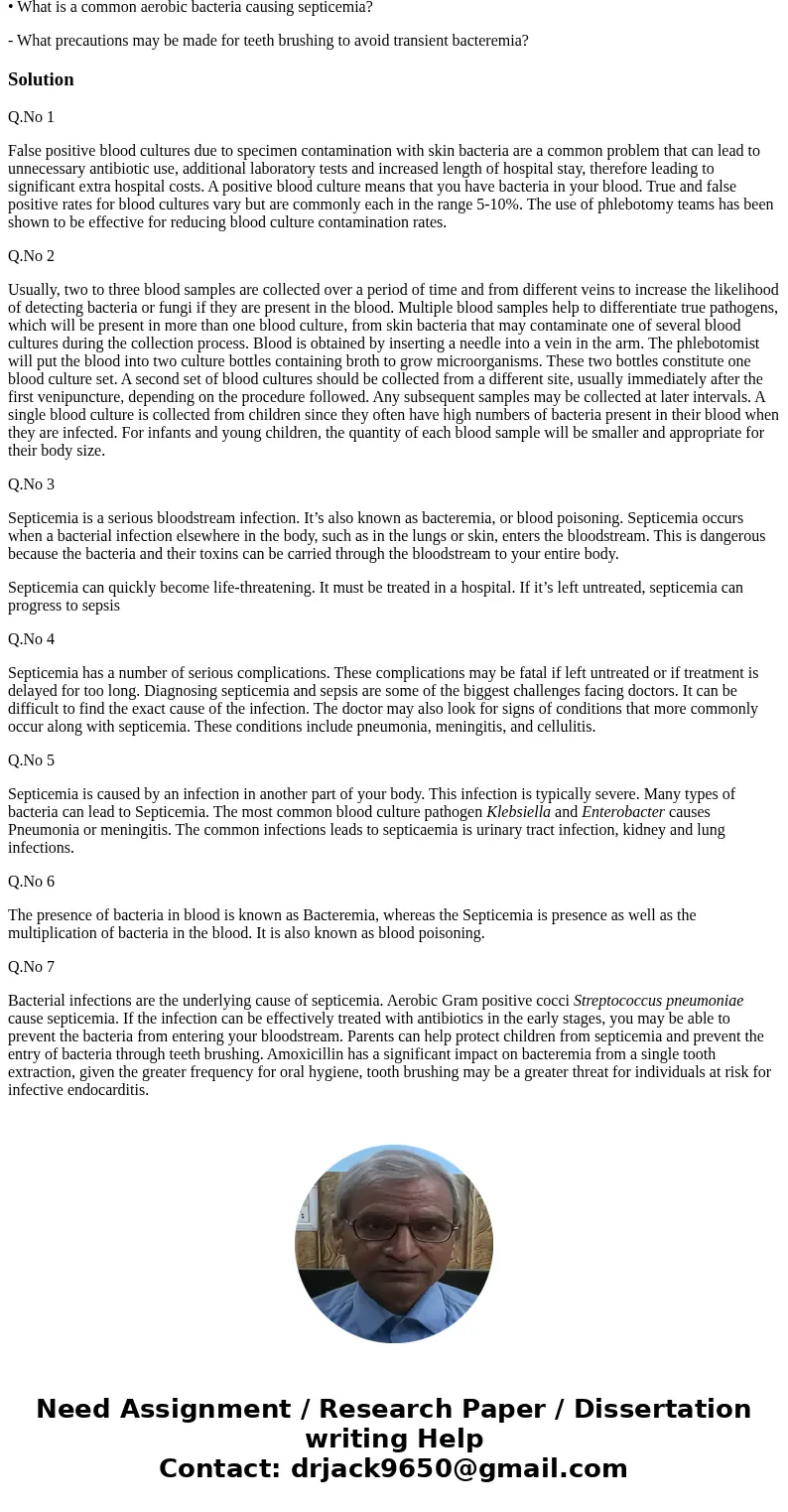Clinical lab How are contaminated blood cultures distinguis
Clinical lab:
• How are contaminated blood cultures distinguished from true positive blood cultures?
• What is the purpose of collection of multiple blood culture bottles?
• Describe septicemia disease course (be specific).
• What is the urgency associated with prompt and accurate diagnosis of septicemia i.e. what are implications of delaying treatment of septicemia.
• From resources, indicate the most common blood culture pathogen (cause of septicemia.)
• Distinguish between bacteremia and septicemia.
• What is a common aerobic bacteria causing septicemia?
- What precautions may be made for teeth brushing to avoid transient bacteremia?
Solution
Q.No 1
False positive blood cultures due to specimen contamination with skin bacteria are a common problem that can lead to unnecessary antibiotic use, additional laboratory tests and increased length of hospital stay, therefore leading to significant extra hospital costs. A positive blood culture means that you have bacteria in your blood. True and false positive rates for blood cultures vary but are commonly each in the range 5-10%. The use of phlebotomy teams has been shown to be effective for reducing blood culture contamination rates.
Q.No 2
Usually, two to three blood samples are collected over a period of time and from different veins to increase the likelihood of detecting bacteria or fungi if they are present in the blood. Multiple blood samples help to differentiate true pathogens, which will be present in more than one blood culture, from skin bacteria that may contaminate one of several blood cultures during the collection process. Blood is obtained by inserting a needle into a vein in the arm. The phlebotomist will put the blood into two culture bottles containing broth to grow microorganisms. These two bottles constitute one blood culture set. A second set of blood cultures should be collected from a different site, usually immediately after the first venipuncture, depending on the procedure followed. Any subsequent samples may be collected at later intervals. A single blood culture is collected from children since they often have high numbers of bacteria present in their blood when they are infected. For infants and young children, the quantity of each blood sample will be smaller and appropriate for their body size.
Q.No 3
Septicemia is a serious bloodstream infection. It’s also known as bacteremia, or blood poisoning. Septicemia occurs when a bacterial infection elsewhere in the body, such as in the lungs or skin, enters the bloodstream. This is dangerous because the bacteria and their toxins can be carried through the bloodstream to your entire body.
Septicemia can quickly become life-threatening. It must be treated in a hospital. If it’s left untreated, septicemia can progress to sepsis
Q.No 4
Septicemia has a number of serious complications. These complications may be fatal if left untreated or if treatment is delayed for too long. Diagnosing septicemia and sepsis are some of the biggest challenges facing doctors. It can be difficult to find the exact cause of the infection. The doctor may also look for signs of conditions that more commonly occur along with septicemia. These conditions include pneumonia, meningitis, and cellulitis.
Q.No 5
Septicemia is caused by an infection in another part of your body. This infection is typically severe. Many types of bacteria can lead to Septicemia. The most common blood culture pathogen Klebsiella and Enterobacter causes Pneumonia or meningitis. The common infections leads to septicaemia is urinary tract infection, kidney and lung infections.
Q.No 6
The presence of bacteria in blood is known as Bacteremia, whereas the Septicemia is presence as well as the multiplication of bacteria in the blood. It is also known as blood poisoning.
Q.No 7
Bacterial infections are the underlying cause of septicemia. Aerobic Gram positive cocci Streptococcus pneumoniae cause septicemia. If the infection can be effectively treated with antibiotics in the early stages, you may be able to prevent the bacteria from entering your bloodstream. Parents can help protect children from septicemia and prevent the entry of bacteria through teeth brushing. Amoxicillin has a significant impact on bacteremia from a single tooth extraction, given the greater frequency for oral hygiene, tooth brushing may be a greater threat for individuals at risk for infective endocarditis.


 Homework Sourse
Homework Sourse